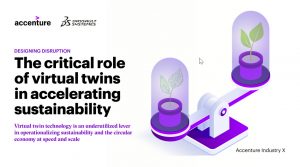Earlier this year, we shared the news that we collaborated with Accenture on a paper to advance the idea that virtual twins may hold the key to meeting the world’s sustainability goals. One aspect of Designing Disruption: The Critical Role of Virtual Twins in Accelerating Sustainability is an exploration into virtual twin use cases from five industries: construction, consumer packaged goods, transportation, life sciences, and electrical and electronics. The report discovered that these examples alone have the potential to unlock more than 7.5Gt of CO2e emissions reductions through 2030 and US$1.3 trillion of economic value.
You can discover the full paper here. But in this post, we are taking a deeper look into one of the five industries: electronics.
Did you know e-waste is the fastest-growing waste stream in the world?
The electrical and electronics industry is a major player in the global economy. The consumer electronics sector alone is estimated to have a market value of $1 Trillion worldwide – probably not surprising when you think about how integrated these technologies are in our daily life. But also think about how often you need to replace your devices. What happens with the outdated ones?
Designing Disruption: The Critical Role of Virtual Twins in Accelerating Sustainability suggests two main ways virtual twin technology can help reduce e-waste. First, by extending product life by promoting more device repair and reuse; this one of the biggest sustainability challenges faced by this industry since in 2019, only 17.4% of global e-waste was properly disposed of, collected and recycled. Second, by increasing recycling rates by ensuring downstream value chain participants have more complete digital information on material and chemical content. The researchers found that using virtual twins to increase refurbishment and re-use rather than recycling for material recovery could generate $73 billion USD in value. Further, this approach has the potential to lower CO2e emissions by 36 Mt: 31 Mt by improving refrigerant release and 5 Mt by avoiding emissions associated with extending a product’s life.

The paper explains how a virtual record of the actual health and performance status of a device’s components can support repair process planning. It also reveals that, when end of life is reached, the enhanced digital continuity inherent in virtual twins can help accelerate and improve the recycling process. Why? Because a virtual twin creates a constant flow of information between value chain participants, which helps preserve knowledge that will eventually help a recycler quickly identify appropriate next steps without needing new tests or inspections.
The reports shares an example one company doing just this this. Dutch startup Circularise is focused on commercializing blockchain-based transparency and traceability technologies for the circular economy. They have developed a solution to help share information about product material content and flows along the value chain, which ultimately results in a QR code that provides important data for recyclers.
One more area examined in the paper is how the electric and electronic product development process can benefit from embedded circular economy principles. This supports the creation of more durable and efficient products that are easier to repair, put apart and recycle. It also helps optimize resource use across the product lifecycle. The 3D modeling and simulation tools in virtual twins, along with data analytics and enhanced collaboration, empower development teams to easily explore unlimited ideas to reach their company’s sustainability goals. The paper provides an example of a global manufacturing computer hardware that set a goal to reduce the embedded carbon footprint of a new computer by 45% and increase the use of recycled structural materials by 50%. Virtual twin technologies enabled the company to reach their goals: the new product has a lower carbon footprint of 47% compared with the previous generation, and a shell made of 100% recycled materials.
 Download the paper now to get more insights on the nascent role of virtual twin experiences in the electronics industry, from e-waste recycling to zero-waste operations to optimize product development. You’ll also more broadly discover how virtual twin technologies can deliver significant sustainable innovation at scale in order to achieve the UN SDGs and redesign the global economy to be more circular and low carbon.
Download the paper now to get more insights on the nascent role of virtual twin experiences in the electronics industry, from e-waste recycling to zero-waste operations to optimize product development. You’ll also more broadly discover how virtual twin technologies can deliver significant sustainable innovation at scale in order to achieve the UN SDGs and redesign the global economy to be more circular and low carbon.
Learn even more!

